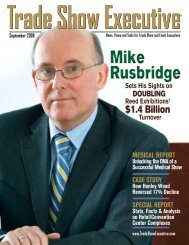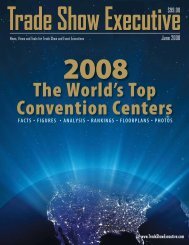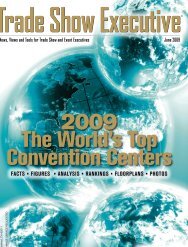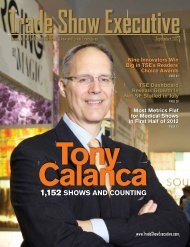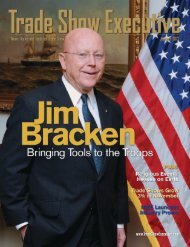Trade Show Executive
Trade Show Executive
Trade Show Executive
Create successful ePaper yourself
Turn your PDF publications into a flip-book with our unique Google optimized e-Paper software.
“The traditional<br />
model of operating<br />
a convention center at<br />
a loss with the premise<br />
of bringing outside<br />
dollars into a community<br />
is not sustainable,” said<br />
James Rooney, executive<br />
director, Massachusetts<br />
Convention Center<br />
Authority (MCCA).<br />
The model was<br />
created during the last<br />
half of the 20th century when<br />
trade shows expanded dramatically<br />
in the U.S. Cities of all sizes built<br />
first-class convention centers, and the<br />
inventory of meeting and exhibit space<br />
skyrocketed to meet the demand.<br />
“Destinations bought into the idea<br />
that all the economic impact generated<br />
by events is reward enough for building,<br />
maintaining and upgrading facilities.<br />
It was acceptable for convention centers<br />
to operate as loss leaders,” said Rooney.<br />
However, demand slowed noticeably<br />
after 9/11 and the recession, as growth<br />
dropped from the high double digits to<br />
single digits, or fell into the red. Domestically,<br />
new show launches were rare. Some<br />
shows in sectors under pressure fell by the<br />
wayside. As sales and other tax revenues<br />
lagged during the recession, the pressure<br />
from local government officials increased<br />
as cities sought ways to decrease expenses<br />
and increase revenue.<br />
Today, lower<br />
sales and tax revenues<br />
continue to plague cities.<br />
To make up for the shortfalls,<br />
budgets for city services such as<br />
police, fire, education and road maintenance<br />
continue to be slashed. “Many<br />
destination leaders originally agreed to<br />
invest in building many of these centers<br />
as economic generators, not net revenue<br />
generators,” said Victoria Isley, executive<br />
vice president and chief operating officer,<br />
Destination Marketing Association International<br />
(DMAI). “Somehow that was<br />
forgotten between the economic downturn<br />
and a saturation of new buildings.”<br />
At the same time, some associations<br />
have dealt with decreasing membership<br />
and lower attendance at their annual<br />
conventions. <strong>Trade</strong> show managers, facing<br />
cost pressures of their own, are driving<br />
hard bargains including demands for<br />
highly discounted rent or free rent — or<br />
they will take their show elsewhere. “These<br />
groups are looking for more concessions<br />
in rent as they focus on increasing revenues,”<br />
said Rooney. “I don’t blame them.<br />
They are just trying to make the best<br />
business decisions for their organizations.”<br />
“Meanwhile, government officials are<br />
questioning the convention center lossleader<br />
model, and it’s getting harder and<br />
harder to justify the value,” said Rooney.<br />
“It’s getting tougher to sustain subsidies<br />
and maintain top-notch facilities with<br />
Continued on page 40<br />
www.<strong>Trade</strong><strong>Show</strong><strong>Executive</strong>.com | March 2013 39



